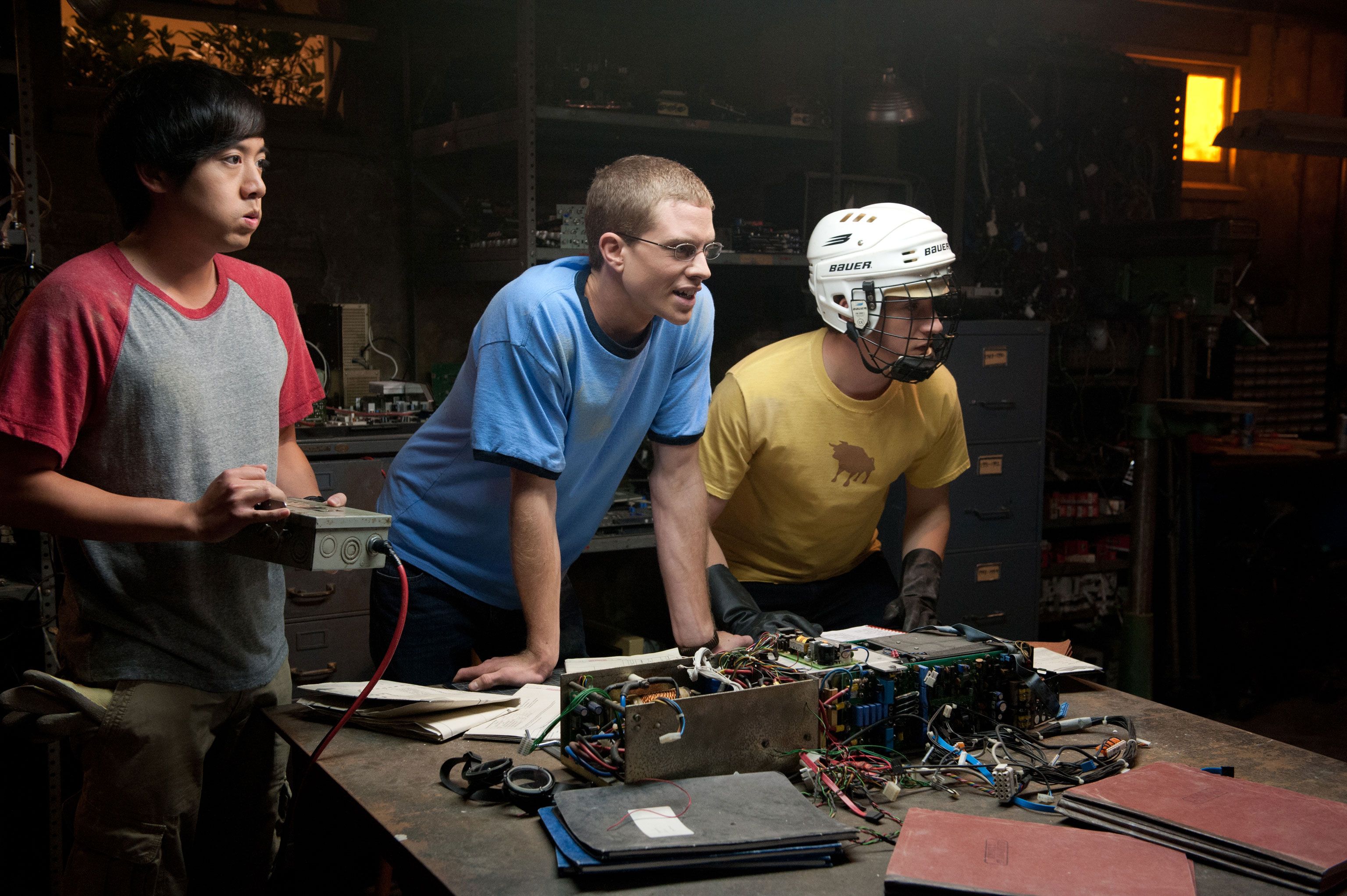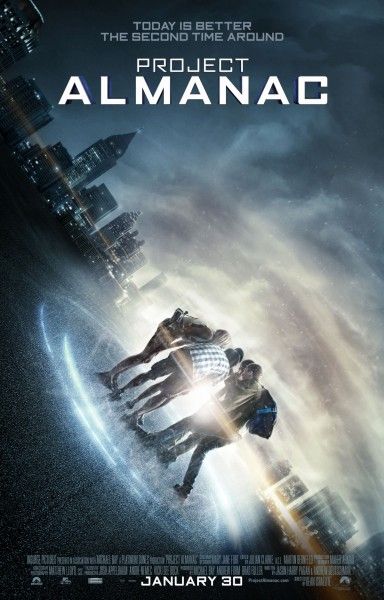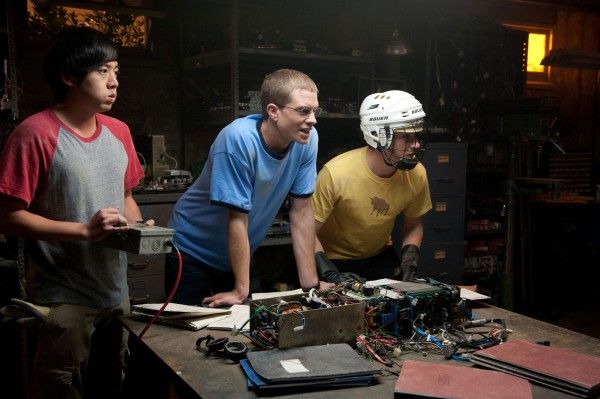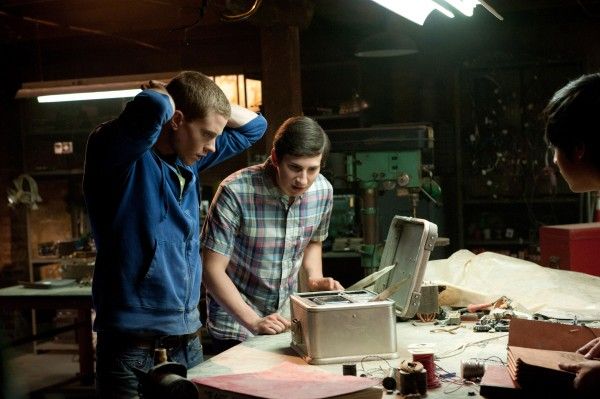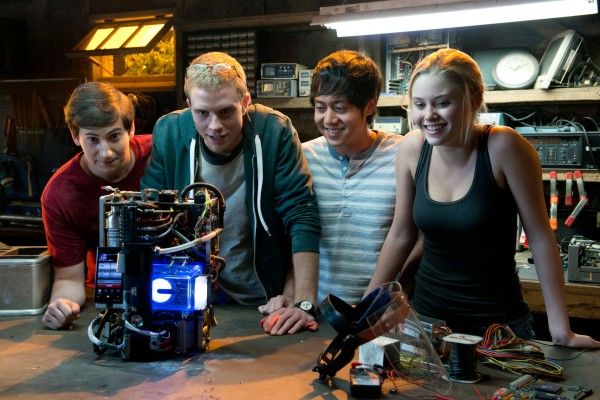Thanks to the overabundance of found footage films, the moment Project Almanac was announced, first-time feature writer Andrew Stark was hit with one serious uphill battle. When you’re one shaky cam movie of many, you’ve got a lot to prove, but Stark and co-writer Jason Pagan were determined to make a standout by providing credible reasons for the characters to be filming and also highlighting the fact that time travel isn’t a defined concept. The kids in the movie are only first putting the pieces together and figuring out the rules, and Stark wants you to do enjoy doing that right along with them.
While on the Project Almanac set back in July of 2013, we got the chance to get the details on the process of bringing the time travel scenario to screen straight from Stark. Catch what he told us about penning the script on spec, maintaining a degree of time travel logic, a connection to Back to the Future and much more after the jump. Project Almanac hits theaters on January 30th.
Question: You wrote this on spec, right?
ANDREW STARK: Yes.
So where did you come up with the whole thing from?
STARK: Someone was telling us a story about one of the largest photo libraries in the world and the insane requests that they get for pictures of Joan of Arc, pictures of Jesus, just things that are literally historically impossible to have photographs of and it made us think about what would be interesting about being able to go back in time and bring a video camera with you and see what things really looked like. And then we wrote this section in the middle where the kids were building the machine itself and learning to use it and testing it, and it actually was the most interesting section of the movie and so we sort of were like, let's go back in history some other time. Let's just actually play with the time machine all through the movie and watch kids try to get back further and further and further, and do more damage in their life and treat time travel as more of a super power than just a place to go to like other movies have. And then shoot the whole thing with a video camera.
How much are you thinking about the found footage element when you're writing?
STARK: Constantly. Constantly. You're constantly trying to figure out, why is the camera turned on in this scene, and having a credible reason for it. And it's a very difficult thing because we didn't want to bend over backwards and unveil a character who suddenly is like, ‘I'm filming everything because I just film everything now.’ You need to believe that and in some movies I think it’s worked very, very well, and I think it works well once so we didn't feel like we could do it again. We wanted to try and create a sense that these were moments that would credibly be captured because something special was happening and somebody was turning something on or make you believe in the character enough that they would actually just want to capture this moment in their everyday life. So, it's a little bit more, I think, ambitious in that way, but as opposed to just like, ‘This event has happened and we're covering everything because of security purposes now,’ it was just like these are kids, they're doing something amazing and hopefully everybody believes that, in this moment, they would turn a camera on because something awesome is happening in their lives.
Were you putting camera cues in your script?
STARK: Not really … when something in the story was important, we called it out and just sort of let that be somebody else's problem.
When you first did the script you said it went back to the 1800s, so how has it developed over the years?
STARK: Yeah, it was just in the initial concept in creating the idea. It wasn't really so much that there were various drafts or something. We worked with Brad [Fuller] and Drew [Form] and we just sort of kept getting the movie tighter and tighter and tighter, and eventually we found the right rhythm. It was a tough needle to thread because we tried to make it as grounded a time travel movie as humanly possible, and you can trip over yourself. And even at certain times we would write out or map out threads of the movie that we would come back to and go, ‘Oh, that doesn't work logically,’ so it was always that kind of touch and go challenge.
Was it tough that for a time travel movie, you have to think about every beat and the cause and effect? How much do you concentrate on that? There’s always going to be plot holes. It’s almost impossible.
STARK: It's funny. How do I put it? We tried to do two things. One is that, in any time travel movie, like in any movie, problems arise as you continue along and one of them is related to the fact that something unexpected has to happen. In time travel, something unexpected has to happen and it usually means the logic that the characters assumed would hold for what traveling through time is, something double backed on them, something unexpected happened. So there's that and the other thing is that we're just trying to figure out this way of saying, ‘Yes, there are rules, but this is a movie about discovering those rules, not just taking them for granted.’ To a certain degree, trying to be the first time travel movie that says like, ‘Time travel is a little messy. It's not always exact. If you tear a piece of paper, it's not clear that this is going to be the consequence to it,’ so it's really about the characters figuring those things out along the way and how to use it, and having setbacks and missteps, and so hopefully by the end of the movie, you've learned some of the rules of time travel, but you know that there are still other things that are out there for the kids to figure out.
How much did you rely on your favorite movies that deal with time travel and the rules that are already out there versus your own? Did you have a chart on the wall somewhere that you followed, whether it's from a movie or not?
STARK: No, we never had a chart so much on the wall. I mean, we tried to stay within our own box and make sure that when we did one thing, we did the other, but obviously that's difficult, too. But yeah, we're fans of pretty much every time travel movie. I mean Back to the Future one. Back to the Future 2 actually we're big fans of. [Laughs] And you know, we watched Looper and all these things, and sort of just watched what people do. But we didn't really keep a big map anywhere. Though certainly we did draw on a whiteboard. Jason [Pagan] has a whiteboard in his basement that at one point got so overwhelmed that we had to just stop using it.
Brad told us that the title of the movie is the name of the project that the father was working on. Is that a nod to Back to the Future?
STARK: The movie is fraught with sort of Easter eggs and secrets and little moments and things that harken back to many different parts of mythology. One of which being that, in our head at least, the original people who started designing the blueprints were fans of time travel movies and certainly some wiseass in this sort of DARPA covert operation decided to name it after something he was a fan of. That was in our heads, at least. I hope I don't get sued for that.
You're allowed to use that word. Just don't call it Grays Sports Almanac.
STARK: We came up with the word because we wanted to name it after the secret project that it was and we started using - because we're intelligence junkies - we started actually using a random word generator, which is how they actually do name covert projects, and then that word came up and as soon as that did, we were like, ‘Oh, that makes sense, and that connects back to this because it was this year they probably built it.’ I'd love to take full credit, but somewhere is a website that you just keep pushing spacebar. We just got lucky that that word came up.
When the script went from a hybrid found footage film to fully found footage, how challenging was that for you to rewrite it or was it mostly from a directorial standpoint?
STARK: Actually, not very because originally it was a completely found footage and then we started thinking about it more as a hybrid and then we went back to the original intent. So it was really just going back and thinking about what we had. Certain scenes we created that hadn't been in any of those original drafts that we had to sort of figure out and work in, but it wasn't that difficult.
Can you tell us about the character development and learning about who they are as individuals beyond the time travel plot?
STARK: I mean, it's funny. The characters have always remained relatively consistent. Adam has always been sort of his own voice, Quinn his own voice, David, too. They're also loosely based on real people to a certain degree, some of whom I'm sure will take issue and some of whom will not. And they're named after real people to a certain degree.
Real people you know?
STARK: Yes, yes. Jason and I, the way we met is we both dated the same girl at the same time and found that out the hard way, and so there is a particular character in the movie who is not the most favorable and she's named after that person. The biggest thing that happened was when the actors showed up and started bringing life to them and we learned from that. They just added so many great details to it and we just kept trying to capture that and capture that. I think Jonny [Weston] brings life to David in a way that we could have never anticipated and a credibility to it that was awesome. And Sophia [Black-D’Elia] is absolutely Jessie, who's also based on - most every female in this is based on a version of an ex-girlfriend. [Laughs]
Including the sister?
STARK: The sister is actually somebody's sister. And no one has dated her. But yeah, you know, it's always been about two very simple ideas - if you could go back and do something over in your life, what would it be, because I don't believe anybody when they say, ‘No, I would never do that.’ No, you absolutely would and you would figure out how to move heaven and earth to do it. And the other thing just is being a 17-year-old kid. You’re sort of sitting on the precipice wondering what you're going to do with your life. You want to do something great and that moment never really changes, and very few of us actually ever gets something that lands in our hands to try and do it, and this is really a story about somebody who gets that opportunity, whether it's a time machine or whether it's inventing Facebook or anything like that. It's just a story about somebody who gets a chance to do something amazing and lasting, and that's what you see.
Can you talk a little bit about going from being an assistant to selling a script?
STARK: I had really good teachers who taught me why movies work and why some movies don't, and watching them work with writers and filmmakers and really trying to get them to hone in on what are the moments that tell a story as opposed to just the noise that tells a story. We always try to keep that in mind so that every scene feels like it has something exciting to deliver on and something that will hopefully make most of the audience remember it. And also, this notion that we see movies as a communal experience and you have to keep that in mind, and the movie has been written for a group of people that are gonna say, ‘Let's go see this movie together,’ because no one ever says, ‘I'm going to the movies.’ It's always, ‘Let's go to the movies,’ and just to always figure out how your storytelling is driving that out.
Check out even more from my Project Almanac set visit:

